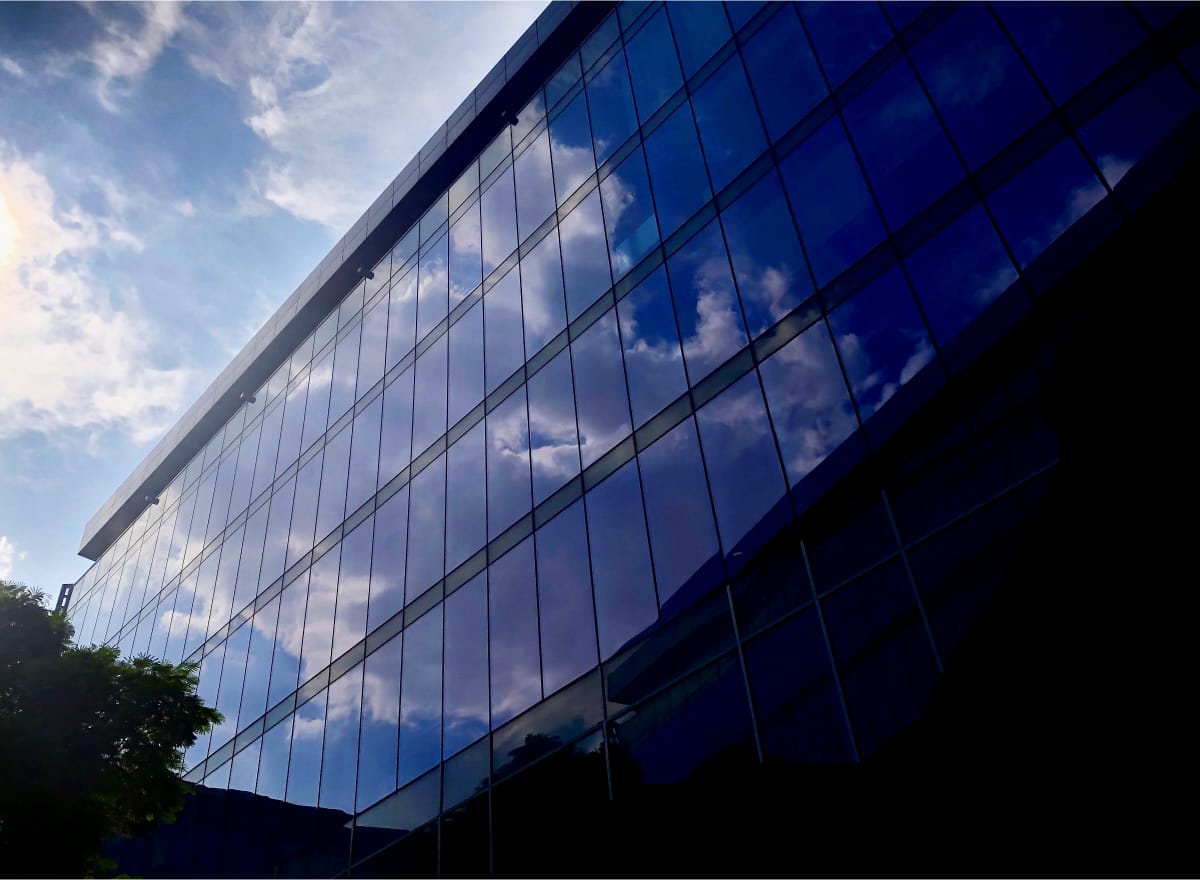Integration of protection objectives and security layers through good design.
In our blog post: “How explosions damage buildings and people,” we took a closer look at the physical properties of explosions and how they actually damage structures and people in and around them. We saw, among other things, that explosive attacks pose a serious threat.
This time, we are examining some of the principles of physical protection in terms of preventing bomb attacks and reducing their harmful effects.
Security solutions through design: The earlier, the better
The physical protection of buildings against explosive attacks is far more effective and cost-efficient when considerations of protection are part of the building’s fundamental design. The earlier, the better.
While almost any solution can be retrofitted to improve a building’s security, the design approach to physical security—where security features are an integrated part of the building’s architecture—is always preferred when possible.
Design allows architects and engineers to incorporate security measures along with aesthetic, everyday operational, environmental, and productivity criteria.
When these other key elements are considered in the earliest project phases, such as defining goals and scope and the conceptual or preliminary design, physical security can be practically invisible, highly effective, functional, and relatively inexpensive.
Of course, this does not mean that the physical security of existing buildings cannot be improved. They can, and it is often seen.
Historical buildings that have been in use for centuries can also be threatened by attacks such as explosives or firearms. But whether the building to be protected is 200 years old or still on the drawing board, one thing is certain: The earlier in the design process security solutions are considered, the better the result.
Goals for physical security
Buildings are always designed with the primary goal of protecting the people in them. Our ancestors used structures to protect themselves from predators, thieves, and others who would harm them.
However, in a time when explosive attacks are a real threat to certain structures, architecture must work together with security systems to prevent, delay, or mitigate the effects of an explosion.
For offices or residences, the highest priority for security design is always the safety of employees and residents.
Loss of life should always be minimized; the building itself is considered a secondary asset, its purpose being to remain standing as long as possible to allow people inside to be safely evacuated.
Critical infrastructure such as power plants, on the other hand, may have slightly different priorities. While preventing loss of life remains the most crucial goal, it may also be important to ensure that the building’s primary purpose (e.g., energy production, water filtration, communication services, etc.) continues uninterrupted or for as long as possible, or resumes as quickly as possible.
As for explosions, design criteria will include some or all of the following requirements:
-
- Preventing the building from collapsing: Historically, a collapse is a deadly consequence of explosions against buildings. Engineers, architects, and security professionals should focus on structural integrity, structural resistance, and protection measures to ensure the building remains standing in the event of a successful attack.
- Stopping progressive collapse: Progressive collapse can lead to high losses and damage to the building’s assets. The alternate path method can be used to stop a progressive collapse, as well as careful attention to the design of components for air blast loading.
- Promoting evacuation and rescue efforts: Good design also takes into account traffic flow after an explosion. It ensures that emergency exits function optimally and allows rescue personnel access to all parts of the structure and its occupants.
- Prevention and limitation of flying materials: Glass and other building materials can become deadly in milliseconds after an explosion, causing human casualties in a building under attack as well as around it. This can be prevented using simple methods.
- Equipment redundancy: While obvious for critical infrastructure, equipment redundancy can also be an important consideration for architects and engineers whose primary interest is protecting people from the effects of an explosion.
Whether the building to be secured is new or existing, in the design approach, as many security solutions as possible are always considered and balanced with all other considerations.
3 primary layers for physical protection
The three primary layers of physical security play an important role in preventing, delaying, and/or mitigating the potentially deadly effects of an attack directed at a building, such as an explosion or vehicle attack.
Protection is maximized when the three layers are thought of as a system. Just as a chain is only as strong as its weakest link, a building’s security solutions are only as effective as the weakest point in any of the 3 layers.
Perimeter: The controlled access zone around the building is the first protection layer and is key to delaying attacks.
This can be done by using passive barriers (e.g., fences, walls, and bollards) and active barriers (e.g., surveillance and guards) to protect and/or strengthen access points to the building and its immediate grounds.
Increasing the distance from the perimeter to the building makes it more difficult to place a bomb close to the building to damage it.
Perimeter security can also provide valuable reaction time to intervene against attackers: even if the perimeter is ultimately breached, barriers can slow or assure an attack and thus improve other defensive reactions.
Shell: The building’s exterior is the second protective layer.
Architectural features can provide some protection against explosions, such as angling the building and facades so that they do not catch explosion waves but reflect them.
Similarly, materials can be chosen for their ability to absorb pressure and impulse and/or for their propensity not to splinter into projectiles in case of an explosion.
Building shells can be retrofitted with special materials to improve their security level. Of course, surveillance at the building shell also plays an important role in detecting suspicious behavior.
Cell: Individual spaces such as offices facing a street up to a certain height, shelters, or server rooms can also be subject to increased physical security against explosions.
This can be done through blast-resistant windows and materials that reinforce the wall against the penetration of flying materials. Other means, such as security locks and/or guards, can also be a way to prevent smaller explosive devices, such as person-borne improvised explosive devices (IEDs), from getting close to their target.
Prevent, Delay, and Mitigate
When considering explosion protection in building construction—or retrofitting existing buildings to be more secure—it pays to apply three separate but interconnected mindsets: Prevention, Delay, and Mitigation.
Prevention: Stopping—or deterring—the attacker at the perimeter, shell, or cell is the ideal scenario, as no damage is caused to the building and no people inside the building are harmed.
The most obvious priorities in prevention are strong defensive measures and difficult-to-pass security systems, both physical and operational. However, there is a balance to be struck between a ‘fortress-like’ design and aesthetics.
While it may be a good idea to make a building or location appear secure, one should also remember the symbolic significance of visible protection. It can signal defense, and that terrorists have achieved their goal of instilling fear. It can also make the location even more tempting to attack. After all, if it’s not valuable, why protect it so highly?
Deception can also be used to make a location appear less secure or less valuable than it actually is. But once again, it may have the opposite effect of the intended one.
The aesthetic balance is just one of the areas where professionals in physical protection can add value to the design process.
Delay: Should prevention fail, the next priority is to delay the attack for as long as possible so that people in the building can be evacuated and additional security measures can be established (e.g., more guards, alarm systems, lockdown security measures, local security forces, etc.).
Buffer zones are used to create this delay, either through the building’s architecture or its protection systems to effectively create a kind of security maze that attackers must navigate and overcome to reach their target.
In some cases, terrorists/attackers may even be forced to cross through non-critical parts of the building. Ideally, the delay will help weaken the attack and save the maximum number of lives possible.
Mitigation: If prevention and delay do not stop an attack, the last resort is mitigation of the attack to weaken its effect. This step can be considered more “passive” than the other two, but that is not the case.
As we have seen above, limiting an explosion involves solid design both in terms of architecture and security level. A building’s ability to mitigate and withstand attacks should be part of its core design—even if it may not always be possible.
For example, older buildings with historical value cannot be rebuilt from scratch and may inherit security flaws that can only be countered by retrofitting physical protection measures.
We hope this illustrates both the opportunities and challenges associated with protecting buildings from explosions and look forward to your comments.


